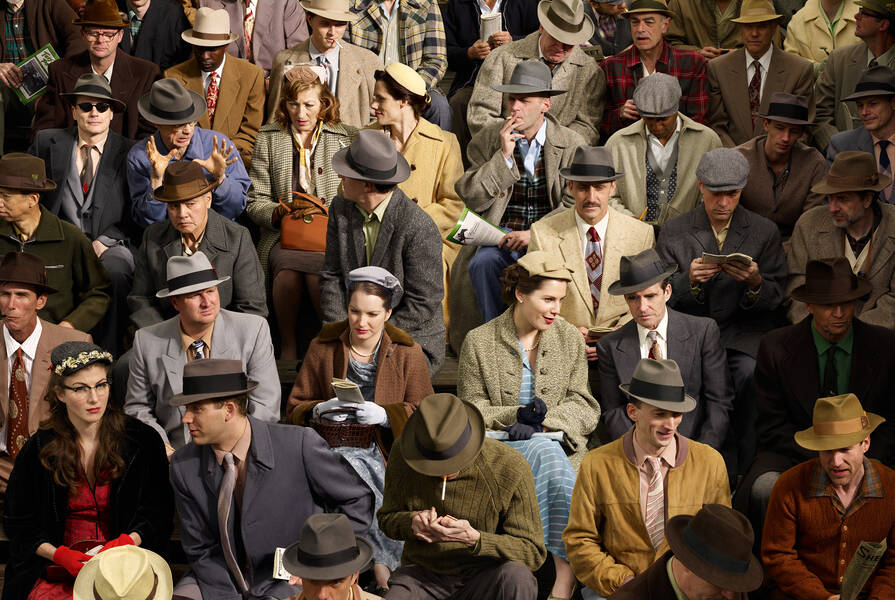
profile / faculty / art / diversity / spring-2022
February 22, 2022
By Solvej Schou
Work images courtesy of Stan Douglas, Victoria Miro, David Zwirner
ARTIST, PROFESSOR AND GRADUATE ART CHAIR STAN DOUGLAS WANTS STUDENTS TO DISCOVER THEIR OWN PATHS
Inside New York City’s new Moynihan Train Hall, Graduate Art Chair Stan Douglas’ permanent work Penn Station’s Half Century—a collection of nine photos arranged as four panels—showcases breathtaking tableaus of performers in period costumes from 1914 to the 1950s.
The 2020 photo mural re-creates little-known moments spanning the 50-year history of New York’s original Pennsylvania Station, which was demolished in 1963. In one photo, an actor depicting Black vaudeville singer Bert Williams sings next to saxophonists, fire baton–wielding jugglers and a clapping crowd. In another photo, an actor playing the Black labor organizer Angelo Herndon walks up a flight of stairs, with flowers strewn at his feet. Douglas used detailed CGI backgrounds to re-create the former station’s majestic and ornate interior.
“A throughline in my work is looking for minor histories,” says the Vancouver- and Los Angeles-based multidisciplinary artist from his Vancouver art studio. “By digging through research and finding out about characters who are forgotten, the reason why they are forgotten means something, and also what made them prominent in their day.”

That is the beauty of the Grad Art department. It’s not siloed into one discipline.
Stan DouglasGraduate Art Chair

Since the ‘80s, Douglas has created detailed photography, video and films—and later, theater productions—filled with historical and cultural references that spark investigations into the concept of collective memory. His work has been exhibited around the world, and he has represented Canada in several Venice Biennales, including this year’s 59th edition of the exhibition, set to take place from April 23 through November 27.
Douglas’ relationship with ArtCenter is a deeply cemented one. Since 2009, he has taught as a professor in the Graduate Art program, bringing his practice-based skills to the program while expanding his thriving career. Before that, he taught at Universität der Künste in Berlin. Last year, he became the most recent Grad Art core faculty member to assume the role of chair, which is a rotating, two-year position.
“The paradox of education is that it’s a process of recognition,” says Douglas. “It’s not about me projecting my own interests and art onto students. It’s about their finding out what they need to know about themselves, and how they can articulate their own practice.”
If this sounds like an egalitarian approach to art education, it is, and intentionally so.
During his years of teaching, Douglas says, he has often witnessed a side effect of having students mentored by one professor: students creating carbon copies of their professors’ work. “So I would never let students see my work, just to avoid that tendency,” he says.
Raised in Vancouver by his mother, an academic researcher and administrator, Douglas grew up loving the plays of Samuel Beckett (he once worked as a theater usher) and the music of David Bowie. After doing printmaking in high school, he studied sculpture at Vancouver’s Emily Carr College of Art, then transitioned to lens-based work. Douglas was one of the first artists to be represented by the David Zwirner Gallery in New York City’s SoHo neighborhood, with his first U.S. solo exhibition held there in 1993. He was knighted last year by the French Minister of Culture .
“Before 2008, I didn’t feature people in my photography, and I was more interested in the mise- en-scène, an open space for action where something might happen,” Douglas says. “But then I did an image with people, and I realized that I really enjoyed working with them. My work changed radically.”
His 2008 photo Hastings Park, 16 July 1955 re-creates a crowd of seated spectators at the Vancouver racing track, talking, moving, smoking, and dressed in ‘50s-era costuming. “The trick is, don't pose them,” Douglas says. “Then, in the process, you can find that moment you want to capture.”

His film and video work includes the video installation Doppelgänger, which debuted at the 2019 Venice Biennale. The piece uses two translucent screens that feature alternating narratives for an astronaut named Alice who is transported to two different planets and realities. Douglas views art as having the freedom to integrate varying mediums. “That is the beauty of the Grad Art department, as well,” he says. “It’s not siloed into one discipline.”
The program, he notes, is unique in its low student-to-teacher ratio, with a wide range of perspectives, whether courses are taught remotely—as during the COVID-19 pandemic—or in person. A recent in-depth lecture series for which guests from around the world tuned in via Zoom included actress, director and writer Lisa Dwan; photographer and multimedia artist Lorna Simpson; and artist, composer and musician Jason Moran. As chair, Douglas also aims to bring in a more diverse student body.
“The level of discourse is so high,” he says. “While in school, students can think through ideas autonomously without the exterior pressure of a career. They also get an amount of attention from the faculty here that they can’t get anywhere else.”
















